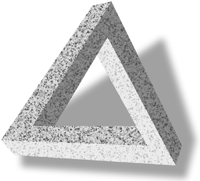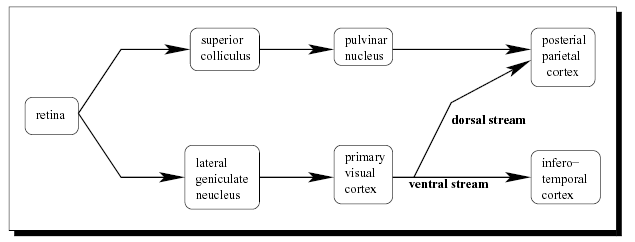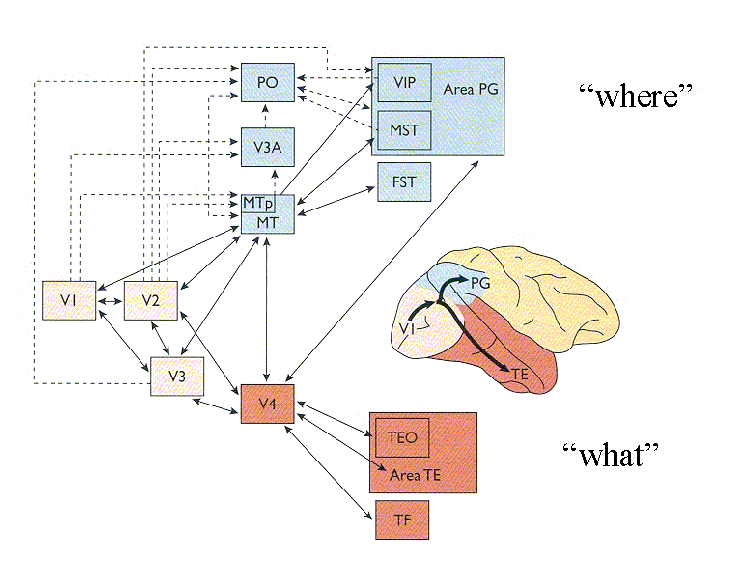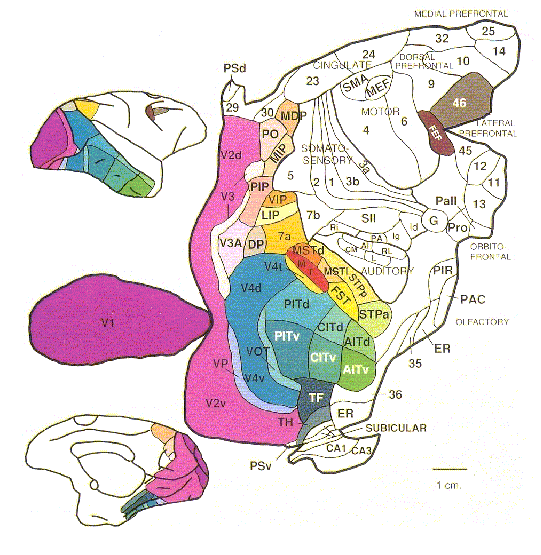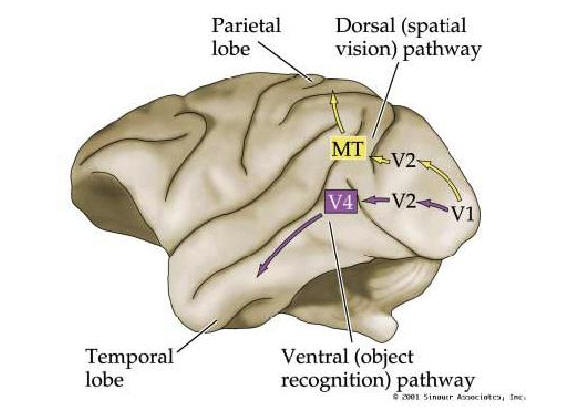CogSci 30PY ProjectA Hybrid Neural Network Model of Binocular Rivalry |
"In another part of Chicago stood the institute for Nuclear Research, in which men may have had theories upon the essential worth of human nature but were half ashamed of them, since no quantitative instrument had yet been designed to measure it." - Isaac Asimov, "Pebble in the sky", 1958. |
| 16.4 | 5.4 | 3.4 | 30.3 | 24.3 |
| 2.5.3 | 1.5.3 Research proposals |
"The most beautiful thing we can experience is the mysterious;
It is the source of all true art and science." -- Albert Einstein
|
Image analysis / synthesis / manipulation Other resources (e.g., The Whole Brain Atlas) Pictures: Visual System Overview, The Where/What streams, The Macaque Cortex, Streams shown on a Brain |
|
This was an interesting project; but now it's all done. My conclusion is a bit depressing for the current research; but hey, let's just do it all over again from the beginning :-) Hehe, enjoy!
Andersen, S. M. (2004). A Hybrid Neural Network Model of Binocular Rivalry (Final Report).
I've dedicated a web-page to the IT cortex.
2.5.03 Neural nets for IT cortex -- Associative memories? Hopfield nets? Grossberg's ART networks?
ART FAQ at
http://www.wi.leidenuniv.nl/art/ and the "ART Headquarters" at Boston
University, http://cns-web.bu.edu/.
For C software, see the ART Gallery at
http://cns-web.bu.edu/pub/laliden/WWW/nnet.frame.html
Hebbian learning is the other most common variety of unsupervised learning (Hertz, Krogh, and Palmer 1991). Hebbian learning minimizes the same error function as an auto-associative network with a linear hidden layer, trained by least squares, and is therefore a form of dimensionality reduction. From the FAQ.
Connecting the terminology to stats:
A vector of values presented at different times to a single input unit is often
called an "input variable" or "feature". To a statistician, it is a "predictor",
"regressor", "covariate", "independent variable", "explanatory variable", etc. A
vector of target values associated with a given output unit of the network
during training will be called a "target variable" in this FAQ. To a
statistician, it is usually a "response" or "dependent variable".
From the
FAQ.
The nature of associative memories -- a lecture
The CS41NN - Neural Networks lecture notes might have something to offer?
Pantic L.,Torres J.,Kappen H.J.,Gielen C.C.A.M. (2002).
Associative memory with dynamic synapses, Neural Computation, volume 14,
pages 2903-2923.
The
Neural Network FAQ:
Sarle, W.S., ed. (1997), Neural Network FAQ, part 1 to 7: Introduction, periodic
posting to the Usenet newsgroup comp.ai.neural-nets, URL:
ftp://ftp.sas.com/pub/neural/FAQ.html
On combining networks (links from the FAQ, part 3)
Sarle, W.S., ed. (1997), Neural Network FAQ, part 3 of 7: Introduction, periodic posting to the Usenet newsgroup comp.ai.neural-nets, URL: ftp://ftp.sas.com/pub/neural/FAQ.html
Christoph M. Friedrich's web page, "Combinations of Classifiers and Regressors Bibliography and Guide to Internet Resources" at http://www.tussy.uni-wh.de/~chris/ensemble/ensemble.html
Tirthankar RayChaudhuri's web page on combining estimators
at
http://www-comp.mpce.mq.edu.au/~tirthank/combest.html
Robert E. Schapire's boosting page at
http://www.research.att.com/~schapire/boost.html
http://www.boosting.org/
Not sure about usefulness of these, but here they are, anyway:
Pantic L.,Torres J.,Kappen H.J. (2003).
Coincidence
detection with dynamic synapses, Network: Computation in Neural Systems,
volume 14, pages 17-33.
Kappen H.J. (2001).
An
introduction to stochastic neural networks, In: Handbook of Biological
Physics, Neuro-informatics and Neural Modelling, volume 4, pages 517-552.
ftp://www.cis.ohio-state.edu/pub/neuroprose
ftp://crl.ucsd.edu/pub/neuralnets
I don't know what you guys think about publishing your research proposals here, but here is mine, anyway:
Andersen, S. M. (2003). A Hybrid Neural Network Model of Binocular Rivalry (Proposal).
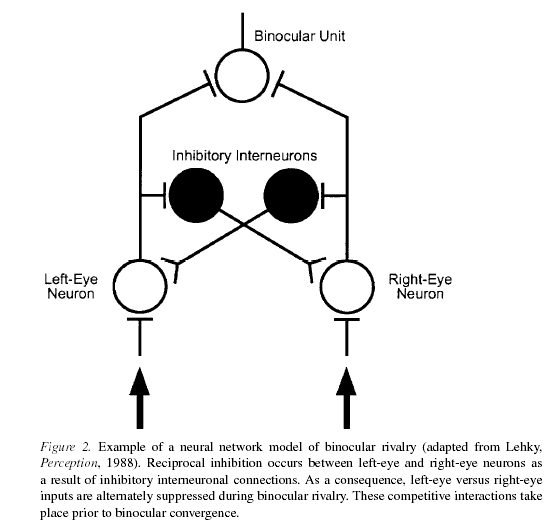
Striate stuff
On the number of Neurons in LGN/V1: An evolutionary Scaling Law for the Primary Visual System and its Basis in Cortical Function (Letters to Nature)
Are there really simple/complex cells? On the classification of simple and complex cells
Yabata (2001). Two Functional Channels from Primary Visual Cortex to Dorsal Visual Cortical Areas
Tong, F. (2003). Primary Visual Cortex and Visual Awareness.
Inferotemporal cortex (IT area) stuff, modelling (& the Visual Journal Club Archive) -& The Ventral Stream
When searching for IT area stuff, be aware that the LOC (lateral occipital complex) area is considered the homolog of macaque IT cortex (Gross et al., 1972; Sary et al., 1993; Kobatake and Tanaka, 1994).
Some DOI-referenced articles can be found through Science Direct.
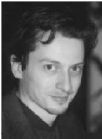 Fusi, S. (2001).
Long term memory:
encoding and storing strategies of the brain. NEUROCOMPUTING, 38,
1223-1228 JUN 2001
Fusi, S. (2001).
Long term memory:
encoding and storing strategies of the brain. NEUROCOMPUTING, 38,
1223-1228 JUN 2001
Paolo Del Giudice, Stefano Fusi (2003). Modeling the formation of working memory with networks of integrate-and-fire neurons connected by plastic synapses. (Found on Computational Neuroscience, University of Berne)
Fusi's PhD thesis.
Storkey, A. (1998). Palimpsest memories: a new high capacity forgetful learning rule for Hopfield networks.
|
Storkey, A. (1999). The basins of attraction of a new Hopfield learning rule.
Nicolas Brunel (1996). Hebbian Learning of Context in Recurrent Neural Networks.
Riesenhuber, M., & Poggio, T. (1999). Hierarchical models of object recognition in cortex. In Nature Neuroscience.
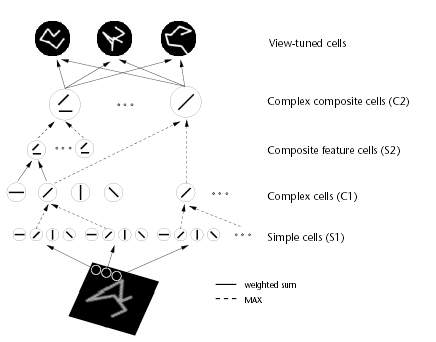
LOC -- analysis of shape. (Kanwisher, N., Chun, M. M., McDermott, J. & Ledden, P. J. Brain Res. Cogn. Brain Res. 5, 55-67)
Neuronal mechanisms of selectivity for object features revealed by blocking inhibition in inferotemporal cortex (in Nature Neuroscience)
Models of Object Recognition (Tanaka, 2000)
Mechanisms of visual object recognition: monkey and human studies (Tanaka, 1997) In Current Opinion in Neurobiology, 7:523–529.
Inferotemporal Cortex and Object Vision (Tanaka, 1996)
Implementing the Expert Object Recognition Pathway Bruce A. Draper (2), Kyungim Baek and Jeff Boody
A Biological Plausible Expert Object Recognition System Kyungim Baek, Ph.D. thesis, Colorado State University, Fall 2002. A picture from his intoduction gives a broad overview:
Kanwisher, N., Tong, F., & Nakayama, K. (1998).
The effects of
face inversion on the human fusiform face area.
Cognition, 68, B1- B11.
Tong, F. (2001). Competing theories of binocular rivalry: A possible resolution. Brain and Mind, 2, 55-83.
16.4.03 Grossberg's Models of cortex
Grossberg's (1999) Laminart model. How does the cerebral cortex work? A diagrammatical figure of LGN - V1 - V2.
Grossberg, S. and Seitz, A., (2003). Laminar Development of Receptive Fields, Maps, and Columns in Visual Cortex: The Coordinating Role of the Subplate. Cerebral Cortex, in press.
Grossberg, S. and Howe, P.D.L. (2002). A laminar cortical model of stereopsis and three-dimensional surface perception. Vision Research, in press
Grossberg, S. and Williamson, J.R. (2001). A neural model of how horizontal and interlaminar connections of visual cortex develop into adult circuits that carry out perceptual groupings and learning. Cerebral Cortex, 11, 37-58.
On Binocular Rivalry (BR) in Wired.
A Fast, Fully Implicit
Backward Euler Solver for Dendritic Neurons (2000)
Steven J. Cox, Boyce E. Griffith -- these guys developed a
HH-type neurons model in C++ (maths and pseudo code in article, code
supposed to be on the web somewhere).
Peter Dayan and Larry Abbott have written a book on theoretical neuroscience, and ch. 7, which just happens to concern network models, is available online. Abbott's homepage is also full of links to pdf's of articles he has written. If you want to look at those and can't read .ps-files, you can find them converted to pdf or html by citeseer or google. Dayan's articles are also available.
A look at classical nn's, with MSVSC++ code at generation5, they also have some introductory texts.
Chris found some of BR-related articles at MIT's AI lab.
Robert P. O'Shea at the psych department @ Otago uni, NZ has compiled a bibliography of Binocular Rivalry articles. Ha has also written some himself:
O'Shea, R. P., & Corballis, P. M. (2003). Binocular rivalry in
split-brain observers. Unpublished manuscript. PDF file (224 K).
O'Shea, R. P., & Corballis, P. M. (2001). Binocular rivalry
between complex stimuli in split-brain observers. Brain and Mind, 2,
151-160. PDF file (28 K).
Randolph
Blake's homepage also has some intro stuff
to BR, and his collection of PDFs
including
A
Primer on Binocular Rivalry, Including Current Controversies
How
context influences predominance during BR
Neuronal
activity in human primary visual cortex correlates with perception during
binocular rivalry
24.3.03
All these papers I've found using Nec's CiteSeer. CiteSeer is an
automatic citation indexer -- so it keeps a record over who cites who. That is,
if you are looking at a paper in CiteSeer, most of the page will be links
to other papers who have cited the paper you are looking at (get it!?!?)
I haven't read them all yet, though... so do your own quality & relevance check... Download options are on the upper right part of the screen for all these links, you can choose between pdf, dejavu, and so on, and so forth...
All these are by Peter Dayan:
A Hierarchical Model of Binocular Rivalry
Recognition in Hierarchical Models
This seems related: Recurrent Sampling Models for the Helmholtz Machine --> what sort of network do we want to use? This discusses one with recurrent connections.
Do we want a supervised or an unsupervised network? Here's an unsupervised (yes, Peter Dayan is co-author):
On brain modelling using networks in general:
Intro chapter in book on neural networks
The What and Why of Binding: Review The Modeler's Perspective
Neuronal model for binocular rivalry
A Spiking Neuron Model for Binocular Rivalry
Binocular Rivalry and Visual Awareness in Human Extrastriate Cortex (PDF) (F. Tong)
Figure from MIT's Hebb server: http://hebb.mit.edu/courses/9.03/persistentactivity/sld005.htm
Figure from http://hebb.mit.edu/courses/9.03/persistentactivity/sld009.htm
Image analysis/synthesis/manipulation
I'm not trying to confuse anyone by putting this stuff here; don't look at it if you don't want to.
An Invitation to 3D Vision: From Images to Models: Image primitives and correspondence (ch. 4)
The World Wide Journal Club -- scientific discussion forums (their collection of papers)
Science Direct (through La Trobe Uni)
Caltech's Vision Lab (unsorted)
Darwin's Origin of the Species (full text from Project Gutenberg)
"It is wrong always, everywhere, and for anyone, to believe anything upon insufficient evidence."
-W. K. Clifford
